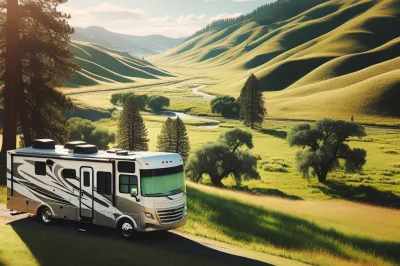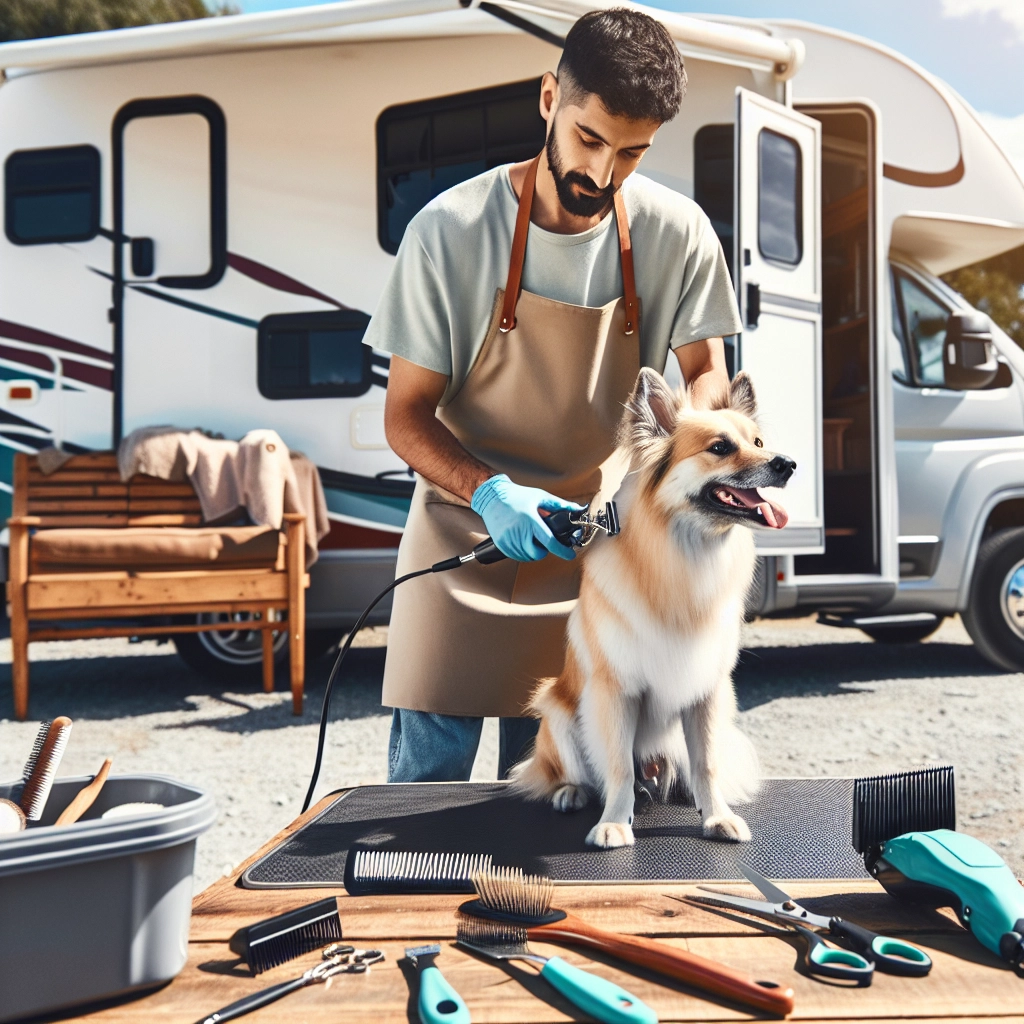Table of Contents

Seamless Power Off-Grid: Choosing the Right Batteries for Boondocking
Imagine the freedom of exploring the wild without a care for the nearest power outlet. That’s the allure of boondocking, but it all hinges on one crucial component – your RV’s batteries. Picking the right batteries isn’t just about keeping the lights on; it’s about ensuring a worry-free adventure where you’re powered up and ready for anything.
Energizing Your Boondocking Adventure
Boondocking, or dry camping, is about being self-sufficient. Your energy source is the lifeline that keeps your essentials running – from the fridge to your phone charger. But how do you ensure you don’t run out of juice when you’re miles from civilization? The answer lies in understanding your power needs and matching them with the right battery setup.
The Heart of Boondocking: Battery Essentials
Your RV’s battery is the heart of your boondocking setup. It stores the energy your solar panels collect, providing power long after the sun sets. But not all batteries are created equal. Some offer longer life spans, while others boast more power or faster charging. The key is to find a balance that suits your boondocking lifestyle.
- Capacity: How much energy can your battery store?
- Lifespan: How many charge cycles can you expect?
- Charge Time: How quickly can your battery go from empty to full?
- Maintenance: How much work will you need to put in to keep your batteries in top shape?
- Temperature Tolerance: Can your batteries withstand the heat of summer and the chill of winter?
Solving Power Shortages with the Perfect Battery
Power shortages can turn an idyllic off-grid escape into a stressful situation. The right battery solution means you can enjoy your favorite comforts without interruption. It’s about more than capacity; it’s about reliability. When you choose a battery tailored to your needs, you’re investing in peace of mind.
Boondocking Batteries Demystified
Let’s get down to brass tacks. Boondocking batteries come in various shapes and sizes, each with its pros and cons. Understanding the differences is your first step towards a reliable and efficient power system. Whether it’s lead-acid or lithium, each type has a role to play in your energy independence.
Types of RV Batteries Suitable for Boondocking
When it comes to boondocking, there are a few contenders on the battery front. Traditional lead-acid batteries are a tried and true option, offering affordability and availability. AGM batteries step up the game with better durability and maintenance-free operation. But the real game-changer in recent years has been lithium batteries, with their lightweight design and impressive life cycle.
- Lead-Acid: Affordable and widely available but require regular maintenance.
- AGM (Absorbed Glass Mat): Spill-proof and maintenance-free with a moderate price tag.
- Lithium (LiFePO4): Higher upfront cost but unbeatable in efficiency, lifespan, and weight.
Advantages of LiFePO4 Batteries in Off-Grid Scenarios
LiFePO4 batteries are revolutionizing the boondocking world. They’re a powerhouse of efficiency, with a long lifespan that makes the initial investment worth every penny. They charge faster, last longer, and are kinder to the environment. Plus, they’re lightweight, which means more power without weighing down your RV.
- Efficiency: They convert more energy into usable power.
- Longevity: Expect thousands of charge cycles with minimal degradation.
- Eco-Friendly: LiFePO4 batteries are less toxic and more sustainable.
- Quick Charging: Spend less time tethered to a charging source.
- Lightweight: Reduce your RV’s overall weight for better fuel efficiency.
Understanding Battery Capacity and Your Power Needs
Capacity is king in the world of boondocking batteries. It’s measured in amp-hours (Ah) and tells you how much electricity a battery can store and deliver over time. To match your battery to your power needs, you need to calculate the total Ah your RV appliances use in a day. Then, choose a battery with a capacity that can handle your daily consumption, plus a little extra for those just-in-case moments.
- Calculate your daily power usage in Ah.
- Choose a battery with a higher capacity than your daily needs.
- Consider future power needs if you plan to add more appliances.
- Remember that using a battery to its full capacity can shorten its lifespan.

Making Sense of Solar Compatibilities
Solar power and batteries are a match made in heaven, especially for boondocking. But it’s not as simple as plugging in any solar panel to any battery. You need to ensure your solar array can generate enough power to charge your batteries effectively. It’s about finding that sweet spot where your solar setup meets your battery bank’s needs without overcharging or undercharging.
Matching Solar Panels with Your Boondocking Battery Bank
When pairing solar panels with your battery bank, consider the wattage of your panels and the charging requirements of your batteries. A good rule of thumb is to have enough solar power to recharge your battery bank from 50% to 100% during a typical day of sunlight. This means if you have a 200Ah battery bank, you’ll want enough solar panels to generate around 100Ah on a sunny day.
- Match solar panel wattage with battery charging requirements.
- Ensure your solar array can recharge your batteries during daylight hours.
- Factor in the average sunlight hours in areas you plan to boondock.
Regulating Charge: Solar Controllers for Battery Longevity
A solar charge controller is the guardian of your battery bank. It regulates the voltage and current coming from your solar panels to prevent overcharging. A good controller will also protect against battery drainage by shutting down the system if it detects low voltage. This piece of equipment is crucial for maintaining battery health and extending its lifespan.
- Choose a charge controller that matches your solar panel output and battery type.
- Look for features like automatic shut-off to prevent over-discharge.
- Consider controllers with additional features like load control and battery temperature sensors.
How to Monitor Battery Health During Long Boondocking Sessions
Keeping an eye on your battery’s health is vital, especially when you’re living off-grid for extended periods. Use a battery monitor to track voltage, current, and discharge levels. This will help you understand your power usage patterns and make adjustments to conserve energy. Plus, it alerts you to any potential issues before they become big problems.
- Install a battery monitor to keep track of key performance metrics.
- Regularly check the monitor to adjust your energy usage as needed.
- Use the data to identify and troubleshoot potential battery issues early.
Maximizing Your Investment: Boondocking Battery Maintenance
Proper maintenance is the secret to getting the most out of your boondocking batteries. Even the best batteries can fail prematurely if neglected. Regular checks and a bit of TLC can go a long way in ensuring your battery bank remains healthy, reliable, and ready to power your off-grid adventures for years to come.
Pro Tips for Extending Battery Life Off the Grid
To extend the life of your batteries, avoid discharging them completely. Deep discharges can strain and damage your batteries, reducing their overall lifespan. Also, keep them clean and check the connections to ensure they’re tight and corrosion-free. If you’re using lead-acid batteries, make sure to top them up with distilled water as needed.
- Avoid deep discharges by keeping your battery charge above 50%.
- Regularly clean battery terminals and check for tight connections.
- For lead-acid batteries, maintain proper water levels with distilled water.
- Store batteries in a cool, dry place when not in use to prevent degradation.
Do’s and Don’ts of Battery Care When Dry Camping
When you’re miles from the nearest power hookup, your battery is your lifeline. It’s crucial to treat it right. Do keep your batteries charged; this extends their life and ensures they’re ready when you need them. Don’t let them discharge too deeply, as this can cause irreversible damage. Do keep them clean and free from corrosion; a dirty battery can lead to poor connections and reduced efficiency. Don’t expose your batteries to extreme temperatures; excessive heat or cold can shorten their lifespan.
- Do regularly inspect your batteries for any signs of wear or damage.
- Don’t mix old and new batteries, as this can lead to uneven charging.
- Do ensure proper ventilation to prevent gas buildup, especially with lead-acid types.
- Don’t ignore the manufacturer’s maintenance recommendations.
- Do use a high-quality charger that’s appropriate for your battery type.
Staying Powered: Frequency of Battery Upkeep
Consistent battery maintenance is key to reliable power. The frequency of upkeep depends on the type of battery you have. For example, lead-acid batteries require water levels to be checked monthly, while lithium batteries need far less hands-on care. Always monitor your battery’s charge levels; keeping them between 50% and 80% charged will help maintain their health and longevity. Perform a thorough inspection at least twice a year to ensure everything is functioning correctly.

Top Picks for Boondocking Battery Solutions
Choosing the right battery for your RV can be a game-changer for your boondocking experience. I’ve rounded up top picks that cater to different needs and budgets, ensuring you can find the best fit for your off-grid adventures.
1. Premium Power: The Best Overall Boondocking Battery
The Battle Born LiFePO4 Deep Cycle Battery stands out as the best overall choice for boondocking. Its lithium iron phosphate technology offers a remarkable blend of longevity, efficiency, and power. With a lifespan of over 3000 cycles and a built-in Battery Management System (BMS), it’s a top-of-the-line option for those who don’t want to compromise on quality.
“With the Battle Born battery, I’ve powered my RV for weeks at a time without a hitch. It’s the peace of mind I need when I’m exploring the backcountry.”
2. Runner-Up: The Next Best Thing in Boondocking Power
Coming in close is the Renogy Deep Cycle AGM Battery. It’s a solid choice for those looking for reliability without the hefty price tag of lithium. This battery is designed for deep discharge applications, making it ideal for long-term boondocking. It’s also maintenance-free, which means less hassle for you on the road.
3. Budget-Friendly Choice: Powering Up Without Breaking the Bank
The Universal Power Group Deep Cycle VRLA Battery is the budget-friendly pick. It offers dependable performance at a price that won’t drain your wallet. Suitable for those just getting started with boondocking, this battery provides enough power for basic needs while still being durable and easy to handle.
- Cost-effective without sacrificing performance.
- Valve regulated and spill-proof design.
- Good for those new to boondocking.
4. Innovative Integration: Smart Batteries with Bluetooth Connectivity
For the tech-savvy boondocker, the ExpertPower Smart Lithium Battery with Bluetooth is a game-changer. This battery not only offers the benefits of lithium technology but also integrates with your smartphone. You can monitor charge levels, usage history, and health stats all from the palm of your hand, giving you unparalleled control over your power supply.
“The ExpertPower battery’s Bluetooth feature lets me check on my power supply without leaving my campfire. It’s convenience and innovation combined.”
Putting It All Together: Building Your Boondocking Power System
Now that we’ve explored the best batteries and how to maintain them, let’s talk about creating a power system that’ll keep you energized and independent. Combining solar power with the right batteries can lead to an efficient, sustainable energy solution for your RV. It’s a setup that not only saves you money in the long run but also supports your adventurous lifestyle off the beaten path.
DIY Solar Array Set Up for Ultimate Energy Independence
Setting up a solar array may seem daunting, but with a bit of know-how, it’s entirely achievable. Start by calculating your energy needs, then select solar panels that meet or exceed that amount. Mounting the panels securely on your RV’s roof, connecting them to a charge controller, and then to your battery bank, forms the backbone of your solar power system. Remember, the goal is to capture and store enough solar energy to meet your daily power needs.
- Determine your daily energy usage to size your solar array appropriately.
- Choose a mounting system that’s sturdy and can withstand the rigors of the road.
- Connect your panels to a charge controller to protect your batteries from overcharging.
- Ensure your solar array is positioned to maximize sun exposure.
Wiring and Safety: Ensuring a Secure Electrical System
Proper wiring is critical for safety and efficiency. Use high-quality wires and connectors to minimize power loss and prevent potential fire hazards. Always follow the recommended gauge for your system’s voltage and current. Secure all connections, and consider using a professional electrician to review your work. Safety should never be compromised, especially when you’re relying on your system in remote locations.
- Use the correct wire gauge for your system’s amperage to prevent overheating.
- Ensure all connections are tight and secure to avoid electrical shorts.
- Consider a professional inspection to verify the safety of your setup.
- Regularly check your wiring for signs of wear or damage, especially after long drives.
Step-by-Step: Creating Your Customized Boondocking Battery Solution
Every boondocker’s power needs are unique, so your battery solution should be tailored to fit. Start by listing all your appliances and their power consumption. Next, decide on the type of battery that suits your lifestyle and budget. Then, calculate the total capacity needed and consider future expansions. Finally, install your battery bank, ensuring it’s well-ventilated and accessible for maintenance.
- List your appliances and calculate total power consumption.
- Choose a battery type that aligns with your power needs and travel habits.
- Calculate the total battery capacity needed, adding a buffer for peace of mind.
- Install your battery bank in a location that allows for proper ventilation and easy access.
Gearing Up for Your Next Off-Grid Adventure
As you prepare for your next boondocking trip, it’s essential to have all the right gear to ensure a smooth and enjoyable experience. From power inverters to portable generators, each piece plays a role in your energy independence. Let’s look at the must-have accessories that will complete your boondocking power kit.
Essential Accessories for Your Boondocking Power Kit
Alongside your batteries and solar panels, there are a few key accessories that can make all the difference. A power inverter will convert DC battery power into AC power for your household appliances. Portable generators can serve as a backup power source. Surge protectors will safeguard your system from unexpected power spikes, and quality connectors will ensure efficient power transfer.
- Power inverter to convert DC to AC for regular appliances.
- Portable generator for backup power during prolonged cloudy days.
- Surge protectors to keep your system safe from voltage spikes.
- High-quality connectors and wiring for efficient power transfer and safety.
Planning Ahead: Power Management Strategies for Boondockers
Effective power management is crucial when living off-grid. Plan your energy usage around the sun’s availability, using high-energy appliances during peak sunlight hours. Invest in energy-efficient appliances and LED lighting to reduce consumption. Monitor your power usage with a battery monitor, and always have a contingency plan, such as a backup generator or extra battery capacity, for those unexpected situations.
- Use energy-intensive appliances when solar power is at its peak.
- Upgrade to energy-efficient appliances to reduce overall power consumption.
- Keep a close eye on your power usage with a battery monitoring system.
- Have a backup plan, like a generator or extra batteries, for emergency situations.
Key Takeaways
Choosing the right battery for boondocking is about balancing capacity, lifespan, and maintenance to suit your off-grid lifestyle. LiFePO4 batteries are a top choice for their efficiency and longevity. Understanding your power needs is critical to selecting the right battery size and solar panel setup. Regular maintenance and smart power management will extend the life of your batteries and ensure a smooth boondocking experience. Always prioritize safety in your electrical setup and consider professional inspections for peace of mind.
Frequently Asked Questions
What Is the Ideal Battery Size for Boondocking?
The ideal battery size for boondocking depends on your specific power needs. Start by listing all your electrical devices and their consumption. As a rule of thumb, aim for a battery capacity that can supply your daily energy usage plus an additional 20-30% for contingencies. For most RVers, a battery bank in the range of 200-400 amp-hours will suffice for basic boondocking needs.
How Do I Calculate My RV’s Power Consumption to Choose a Battery?
To calculate your RV’s power consumption, list all the electrical appliances and devices you use. Note their wattage and how many hours a day you use them. Multiply the wattage by the hours to get the watt-hours per day for each appliance. Add up all the watt-hours to find your daily total, then divide by your system voltage (usually 12V) to get the amp-hours needed per day. This figure helps determine the size of the battery bank you’ll need.
Can I Use Regular Car Batteries for Boondocking?
Regular car batteries are not designed for boondocking. They’re starter batteries, meant to deliver a quick burst of energy to start an engine, not for sustained energy release. For boondocking, you need deep cycle batteries that can provide a steady amount of power over a longer period and withstand repeated discharge and recharge cycles.
How Often Should I Charge My Boondocking Batteries?
Your boondocking batteries should be charged daily to keep them healthy. Ideally, you don’t want to deplete them below 50% of their capacity. Solar panels can charge your batteries during the day, but if you’re experiencing a series of cloudy days, you may need to supplement with a generator or shore power to keep your batteries topped up.
Embarking on a boondocking adventure is an exhilarating experience that connects you with nature and offers unparalleled freedom. With the right battery solutions, you can explore the great outdoors without sacrificing comfort or convenience. Remember, your battery is the lifeline of your off-grid RV setup. Treat it with care, and it will serve you well on countless adventures.
Stay charged, stay wild, and always be prepared for your next off-grid journey. Safe travels and happy boondocking!
- Boondocking RVs: Flexible Solar Solutions – 3 March 2024
- Renewable Energy Tips for Full-Time Boondocking RVers – 2 March 2024
- Boondocking Solar Power Systems: Sizing Options & Solutions for Motorhomes – 1 March 2024
